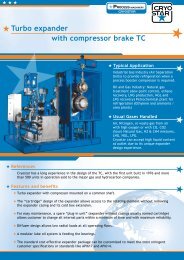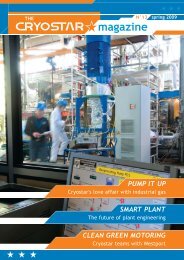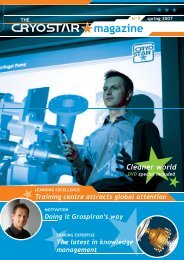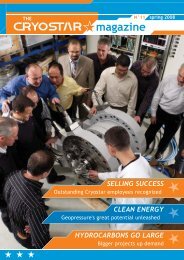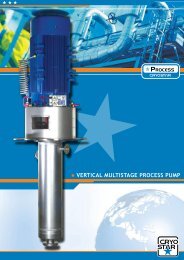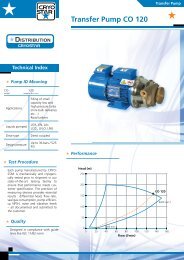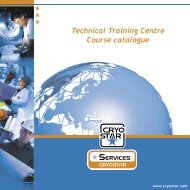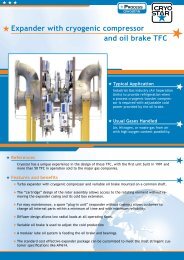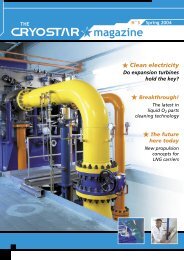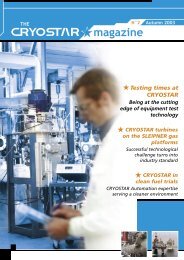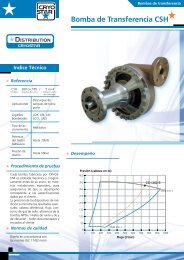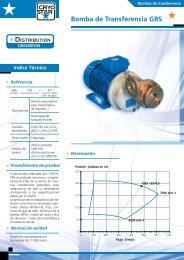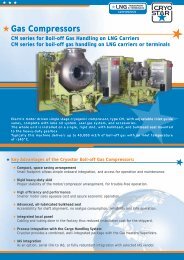The Cryostar Magazine N°7 : pdf file
The Cryostar Magazine N°7 : pdf file
The Cryostar Magazine N°7 : pdf file
You also want an ePaper? Increase the reach of your titles
YUMPU automatically turns print PDFs into web optimized ePapers that Google loves.
PROCESS CONTROL<br />
High pressure flows for new pump<br />
<strong>Cryostar</strong> engineers have developed a new reciprocating<br />
pump specifically for liquid nitrogen at very high<br />
pressures and high flows. <strong>The</strong> HPP75/110 rates up<br />
to 690barg and up to 1100l/min respectively.<br />
<strong>The</strong> new modular concept pump is available with<br />
one cylinder (simplex version), three cylinders<br />
(triplex execution) or five cylinders (quintuplex<br />
execution), which allows a large range of flow at<br />
high pressures (See attached table).<br />
Samuel Zouaghi, <strong>Cryostar</strong>’s Director Distribution<br />
Line, said: “<strong>Cryostar</strong> has served the industrial gas<br />
market with cryogenic equipment for more than 30<br />
years and the launch of the HPP emphasises the<br />
company’s technological edge and continued devotion<br />
to meet customer needs.<br />
“<strong>The</strong> applications of the HPP and the nature of<br />
the cryogenic liquids which can be used are varied.<br />
<strong>The</strong> pump can be utilised as process or back up<br />
pump where high pressures and high flows are<br />
required, for example, pipe line supplying, but there<br />
are also many applications in oil and natural gas<br />
well service, like trailer mounted nitrogen units.”<br />
Cutting-edge technology<br />
Explaining the technology behind the new offer,<br />
Pierre Papirer, Pumps Design Manager, said: “<strong>The</strong><br />
HPP pump been developed in order to ensure its<br />
use for transfer applications as well as for process<br />
applications. <strong>The</strong> lubrication of the crank drive is<br />
made by oil splashing and the bearings assembled<br />
on eccentric shaft are rotating in a closed oil<br />
volume.<br />
“Two special roller bearings absorb the high axial<br />
loads due to the pressure acting on the piston<br />
(about 30tonnes) with low friction coefficient.<br />
<strong>The</strong> new cross-head guiding design, which is also<br />
lubricated by injected oil produces also very low<br />
friction.”<br />
the drive and is activated by the connecting rod<br />
displacement, eliminating any need for external oil<br />
pump and oil tank, said Pierre Papirer.<br />
He added: “<strong>The</strong> power needed by the drive can be<br />
supplied by an electrical motor through a pulley<br />
and belts system or by a thermal motor through an<br />
adequate gear for speed reduction.<br />
“<strong>The</strong> sealing of the drive is obtained by two adequate<br />
seals incorporated in a cartridge, which can be<br />
dismantled without opening the crank drive. <strong>The</strong><br />
frame material of the crank is a strong aluminium<br />
alloy in order to reduce its weight, which is especially<br />
interesting in case of trailer installation.”<br />
Pierre Papirer points out that the coupling between<br />
the cold end and the drive is easy to adjust to get<br />
the adequate clearance between the piston and the<br />
suction valve. It also integrates a plate in order to<br />
vaporise the process liquid in case of leakage.<br />
“<strong>The</strong> design of the cold end is an extrapolation of<br />
the MRP concept developed three years ago, which<br />
now has more than 100 machines in operation. <strong>The</strong><br />
large suction chamber integrating an appropriate<br />
filter and the suction valve design are made in such<br />
a way to reduce the pressure drops at the inlet,”<br />
said Pierre Papirer.<br />
“Additionally, the large vacuum<br />
volume around the cylinder permits<br />
to reduce the cold transfer,<br />
the heat intakes and as consequence<br />
allows getting a shorter<br />
cool down time and minimised<br />
liquid losses.”<br />
<strong>The</strong> low heat generated by the friction<br />
is dissipated by adequate thins<br />
in order to reach an acceptable<br />
balance temperature in continuous<br />
duty. <strong>The</strong> oil lubrication<br />
system is an integrated part of<br />
<br />
Spring 2006



